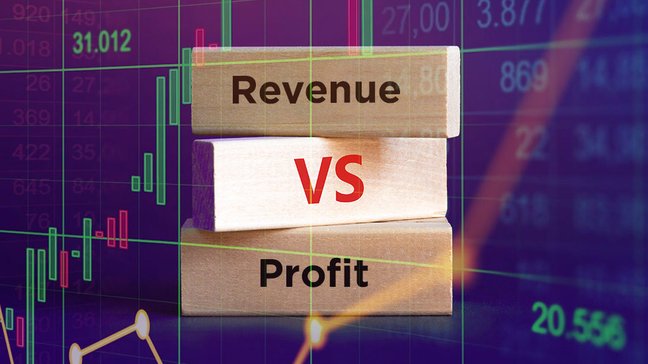The Difference between Revenue and Profit Explained
What is the difference between revenue and profit? These are the two main metrics that help both businesses and investors understand how the company is going. Revenue and profit provide prominent and crucial data about the organisation's performance. Although the terms have some similar features, they are different.

Some beginners do not realise the difference between revenue and profit. In this article, we will clarify the key points letting newbies use these terms correctly.
Are the revenue and Profit the Same?
No, they are not.
Revenue represents the total income that a company managed to generate from distributing products and services it is specialised in.
Profit (also known as the bottom line or net profit) is the income that a company can keep after deducting all costs and expenses including operating costs, debts, amortisation, different types of income streams, etc.
A Brief Revenue vs. Profit Overview
To understand the difference between the two terms clearer, here are some key takeaways to consider:
- Revenue depicts the whole income generated by the company’s primary activities.
- Revenue consists of all the costs, resources and expenses required to perform a company's activities.
- Profit is a separate part of income that a company keeps after deducting all the costs from the primary income.
- Even when generating revenue, a company can be out of profit or have a net loss. This is due to the fact that both revenue and profit are in tight relations with money an organisation can earn within a given period.
up to 200%

from 0 pips

Trading platform

Now, let's have a closer look at each term to better understand the difference between revenue and profit.
Revenue
Experts generally call it the “top line”. This is because revenue can usually be found on top of the income statement. It highlights the entire income before subtracting different expenses.
Example: imagine a retail shop that sells products priorly to accounting for operational costs and other expenses in the revenue. What’s more, if the retailer gets additional investments from subsidiaries or third-party investors, the income cannot be considered revenue, as it is not generated directly from product sales. All extra streams and investments refer to a separate type of funds that also need to be accounted for.
Profit
Also known as net income, profit may come in different variations depending on how you want to evaluate the company’s performance. It can be found in the bottom of the income statement. As stated earlier, it may consist of different classifications:
- Profit margins.
- Operating profit.
- COGS (cost of goods sold).
- Gross profit.
The Key Difference Between Revenue and Profit
Before we describe the main differences, beginner investors should always keep in mind that a company may have net loss (zero profit) even in case it is able to generate revenue. So, these are the factors to consider when overviewing revenue vs. profit.
Revenue and Profit Level
Profit can never be higher than revenue. It is simple maths, as the sum with expenses deducted can never be higher than the sum with all costs initially included.
Sales
Some beginners mistakenly consider revenue as sales. However, it may involve any type of income that a company managed to make before subtracting expenses. At the same time, sales refer only to income that was generated directly for distributing primary services or products.
Importance for the Business
Both revenue and profit are crucial for the company. At the same time, profit is the one to provide the most accurate data and understanding of how the company is performing. It is the best tool to identify the business’s financial position along with expenses, liabilities, and already accounted costs.
The Bottom Line
Both revenue and profit are the crucial data reflected in the income statement. They help investors make well-though decisions based on accurate information about the company’s performance. What’s more, profit can play even a more important role as it shows not only the current financial position but also potential to generate more even with all expenses already deducted.
This material does not contain and should not be construed as containing investment advice, investment recommendations, an offer of or solicitation for any transactions in financial instruments. Before making any investment decisions, you should seek advice from independent financial advisors to ensure you understand the risks.
